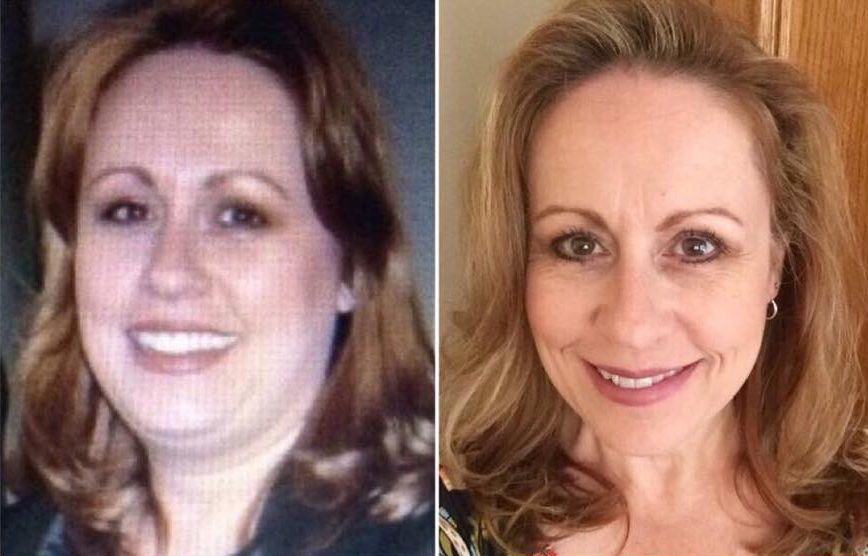Menopause is one of the biggest two-sided stages of human physiology; some might argue whether the loss of fertility is a plus or minus, but few women miss having periods. Menopause may be a factor in making weight loss/weight maintenance more difficult, but it’s hard to separate hormonal effects from the effects of a decrease in physical activity that is common in women (and men) over 50.
The drop in estrogen that comes with menopause can work in a number of ways to cause weight gain or resistance to continuing weight loss. By itself, the drop may cause a decrease in metabolic rate. Since activity often declines too, that leads to decreased muscle mass, which in turn lowers the metabolic rate even further. The muscle loss puts postmenopausal women (affectionately and respectfully referred to as ’pausals henceforth for the sake of brevity) on their way toward frailty.
A double whammy
’Pausals have to deal with the combined effects of a drop in hormonal levels and a cultural inclination toward declining activity levels, which can lead to bone loss and frailty. Frailty is a funnel of death, because once frailty develops, it often comes with a reluctance or inability to participate in physical activities. Virtually every change that develops after the frailty cycle commences reduces the quality of life until there’s no life left. Frailty starts a spiral of:
- loss of strength
- weakening of bones
- loss of agility and movement
- loss of physiologic reserve (the ability to tolerate an injury and recover fully)
- loss of independence
Fortunately, all of the tools described in AC: The Power of Appetite Correction apply across the lifespan—there are no special pre- or post-menopause tools.
Activity advantage
To avoid bone loss (osteoporosis) and frailty, the primary AC tool for ’pausals to remember is Activity. Activity protects against bone and muscle loss, but only in a local fashion. That is, working out with your legs as with biking or running will mainly protect your leg bones and leg muscles, with little, if any, effect on your backbone, shoulders and the associated muscles. To get whole-body bone protection, you can add complementary arm and trunk exercises or use full-body exercises such as yoga, swimming or a balanced weightlifting program. Beyond bone health, there is evidence that exercise including yoga decreases menopausal symptoms and improves quality of life.
Incorporating regular activity into daily life can be challenging, especially in the early stages of building the behavior into a new habit. A 2014 study study of ‘pausals and women on the threshold of menopause offers insights into what influences these groups to engage in daily activity and what commonly deters them:
Enablers
- an established daily structure of exercise (activity)
- anticipating positive feelings associated with exercise (activity)
- accountability to others (connection to a healthy tribe)
Barriers
- Disruption in daily structure (routine)
- Competing demands
- Self-sabotage in response to conflicting feelings (“I don’t feel like exercising” and “I should exercise”)
A Healthy Tribe may be the single most powerful AC tool that can move the needle in favor of adopting and maintaining a habit of daily exercise/activity. That said, for most people, a combination of tools hit the mark for building and sustaining a healthy AC lifestyle.
Tools for tweaking
Besides activity, the other 16 tools for achieving appetite correction still apply—you haven’t run out of options until you’ve tried them all and tweaked them to fit your life as well as you can. ACES (appetite-correcting eating schedules like Fast-5 + tweaks), and, as noted above, Healthy Tribe are particularly important tools. A shorter window or a new social activity that’s not food-centered may be all you need to find the right balance. Remember that any tweak must be given ample time to work (4-8 weeks of consistent use) for three reasons:
- The body takes time to change—little that matters in the scope of a lifetime will show changes immediately.
- Preserving muscle and bone is a preventive step, so when it’s working, there are no changes to see.
- If you can’t build the tool into your life as a sustainable habit, it’s not a good tool for you.
Tend your inner garden
A tweak that’s mentioned in AC: The Power of Appetite Correction but not called out as a separate tool could be called Tend Your Inner Garden. In your gut, the activity of trillions of bacteria influences how your body handles food. The population of bacteria is usually a friendly mix, but if you’ve taken an antibiotic for an infection elsewhere, it may have wiped out many of your healthy gut bacteria. The wipe-out allows the bacterial species that are less susceptible to the antibiotic to grow in greater numbers, upsetting the balance your body had before.
You can help cultivate a healthy garden of bacteria in your gut by avoiding antibiotics except when absolutely necessary and by eating fermented foods such as yogurt and kefir. It’s best to avoid the sweetened versions; start with the plain stuff and add your own flavor or fruit. Taking a probiotic supplement like Culturelle may also help. Eating raw foods from a garden can add to the variety in your gut’s bacterial garden in two ways:
- Some bacteria will remain on the plant no matter how much you wash it.
- The uncooked or less-cooked plant provides more food (fiber) to gut bacteria than fully cooked plants.
Nibbling on vegetables from your own garden during the harvest is okay if you don’t use pesticides, herbicides or fertilize with fresh manure, but if you do, washing first is essential. Take care to wash garden food and any commercially farmed foods (i.e., supermarket produce) grown using pesticides and herbicides to remove as much of the pesticide, herbicide and potentially disease-causing bacteria as possible.
Complex carbohydrates (e.g. beans) are also good “fertilizer” for your gut garden; gas is a byproduct of the bacteria metabolizing the complex carbohydrates in beans and fiber, so moderation may be in order. Note that fiber supplements do not have the same nutrient content as raw vegetables, so whenever possible, augment your intake with high-fiber foods rather than fiber supplements. If high-fiber foods are not practical or available, a fiber supplement is better than no fiber intake at all.
Supplements, vitamins and eating a balanced diet
If you’re eating a balanced diet with lots of fresh foods, it’s unlikely you’ll have any vitamin or mineral deficiencies. Extra magnesium may help a slow-moving gut, and extra calcium citrate with vitamin D3 (commonly known by the brand name Citracal) can help make sure your body has all the calcium it needs to keep your bones healthy.
A brief sidetrack as we consider the price and value of different calcium preparations
Citracal and other brands of calcium citrate with D3 tend to be a little pricier than calcium carbonate or other calcium supplements, so it’s tempting to choose the lower priced supplement. This is one of those times when value favors the pricier choice for this reason:
In taking a calcium supplements, one is balancing the benefits of the supplement with the risk of inducing kidney stones. If you’ve ever had a kidney stone, you know it’s an outcome to avoid! A kidney stone can be extremely painful and can lead to a host of problems. Oral calcium supplements increase the risk of forming a kidney stone, while oral citrate decreases the risk. Calcium citrate combines the two in a nice balance of the benefit of calcium supplementation without significantly increasing the risk of a kidney stone.
Vitamin C may also be helpful in maintaining skin and joint health because it’s needed to make connective tissue.
Reason to celebrate!
Menopause is the end of fertility, but it can be the beginning of a whole new and wonderful chapter in your life. If you’re already active, take steps to stay that way and avoid buying into mistaken assumptions about what ’pausals do and what they don’t do. If you’re relatively inactive, then it’s time to make changes and become active. Invest in avoiding frailty in the decades to come. Take small but determined steps now and build from there. A little bit of change can go a long way, so aim for something sustainable, build your habit, and tweak it from there.



2 comments
Thank you for writing this….
You’re welcome!